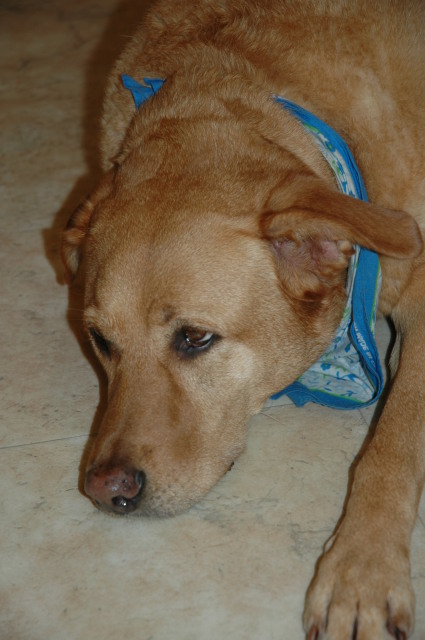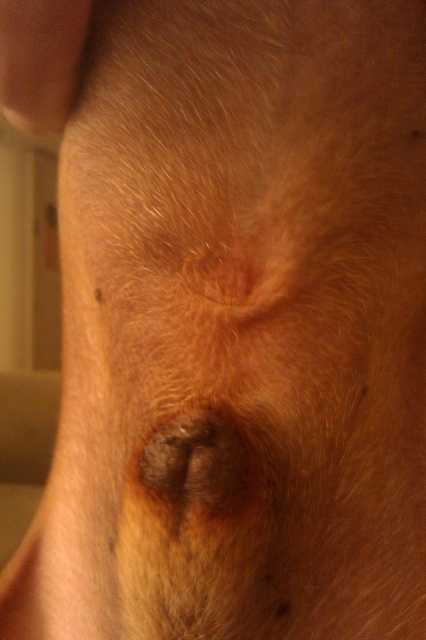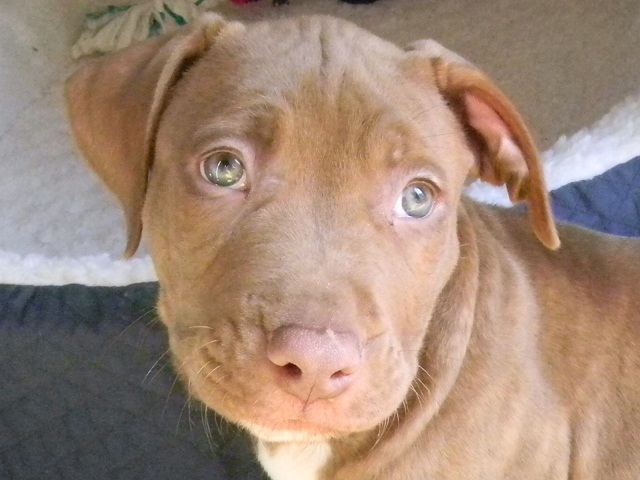QuestionI got a rescued shih-tzu mix about 2 months ago. She's about 10-12 years old and for the last week or so she's been scratching her belly a lot. I took a peek at it to see what the problem was and noticed it's mostly black now (wasn't that way when we got her). It's also a little damp - I don't know if it's from sweating or some kind of bacteria. We put K9 Advantix on her about 3 weeks ago but she continues to scratch her belly. A groomer once suggested peroxide - but I'm not sure. Have you heard of this before?
AnswerHi Celeste,
Your dog's belly isn't damp from sweat, because dogs don't perspire. It's probably wet because your dog has been chewing at her skin in that area.
I'm not a doctor, but this sounds like a condition called Atopic dermatitis. Owners may notice that the dog seems to be licking it's paws or abdomen excessively. Sometimes the ears may be reddened and hot to touch even though not scratched.
As the condition becomes more severe, the itching can dominates the animals' life and specific anti-itch therapy becomes necessary. With increasing itching (called pruritus) baldness (called alopecia) and redness of the skin become evident and secondary yeast or bacteria infections can complicate the treatment.
Saliva staining is a commonly-seen feature in these animals. A red-brown staining of light colored hair is often seen in the areas where itching is the worst. In addition, with long term problems, the skin itself will also change color. Instead of being pink, a black mottling (hyperpigmentation) will slowly develop, especially if the skin has looked red and angry at the site. This is most commonly seen on the abdomen.
Pin- pointing the cause of Atopic dermatitis is often difficult. An allergy to Flea bites, mold spores and dust mites are often the cause of itchiness in dogs.
Food sensitivity (often called food allergy) is an uncommon cause of allergic skin disease.
In treating atopic dermatitis it's important to consider the situation as a whole. Bacterial and yeast infections will make the animal far more itchy and may even contribute to worsening of the condition through damaging the skins' protective mechanisms. So any secondary bacterial or yeast infections need to be treated promptly. Usually the treatment is a combination of shampoos and antibiotics for a minimum of three weeks, and often longer. Sometimes corticosteroid medication are needed to control the itch.
Your dog should be examined by your vet.
Until you can be seen by the vet, wash your dog's belly with a clean cloth and mild soap daily. You can also try a medicated dog shampoo specifically formulated to relieve itching. Shampoos containing 0.5 Hydrocortisone/Lidocaine are usually very effective.
After washing, make sure you dry the area well, since moist skin is a breeding ground for bacterial and yeast infections (which cause more itching). After washing, if your dog will let you dry her belly with a hair dryer that would be great. If you use a towel, pat her dry - rubbing will excite the itch.
You can apply 100% Aloe Vera gel to her itchy belly. It's safe if she licks it, but it's a very effective anti-itch remedy for both dogs and people. You could also dab Witch Hazel onto her belly.
Talk to your vet about using an essential fatty acid supplement. They are widely used for skin conditions. They help about 25% of allergic dogs significantly. Over the counter Antihistamines such as Travist and Benadryl are also very effective in controlling itchy dogs, and work very well in conjunction with the fatty acid supplements. Travist and Benadryl have different active ingredients, so if one doesn't seem to work for your dog, the other brand might help. Talk to your vet regarding proper dosage.
I hope I've been a help.
Best of luck,
Patti

 chihuahua pees on bed
Questionme and boo
QUESTION: I have a 9 month ol
chihuahua pees on bed
Questionme and boo
QUESTION: I have a 9 month ol
 Puppy wont come!
QuestionCapone & Rascal
QUESTION: Help! &nbs
Puppy wont come!
QuestionCapone & Rascal
QUESTION: Help! &nbs
 Senior dog not eating
Question
Meggie Girl
I will be so grateful if you can h
Senior dog not eating
Question
Meggie Girl
I will be so grateful if you can h
 Found Dog
Question
this is what it looks
Hello my is sara and my
Found Dog
Question
this is what it looks
Hello my is sara and my
 10 week old Pitbull Pup
Question
Ares
I have a few questions =]
Why does he ke
10 week old Pitbull Pup
Question
Ares
I have a few questions =]
Why does he ke